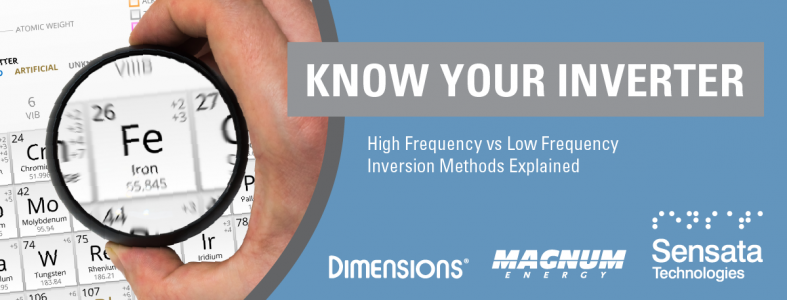
Download this article as a pdf
IRON CORE TRANSFORMERS AND FIELD EFFECT TRANSISTORS
There are two distinct types of industrial grade power inverters distinguished by the size of their transformers, and the switching speed of their transistors. The ability of an inverter to absorb the electrical surges inherent in certain loads like motors, pumps, and torque-related tools is directly proportional to the physical amount of iron present in the transformer. Size and tolerances of the transistors used in the inversion process, and the speed at which they operate determines the classification of high or low frequency.
INVERSION METHODS EXPLAINED
High Frequency Inverters (HF)
The large majority of inverters available in the retail market are high frequency. They are typically less expensive, have smaller footprints, and have a lower tolerance for industrial loads. HF inverters have over twice the number of components and use multiple, smaller transformers. Their application is appropriate for a wide variety of uses like tool battery chargers, small appliances, A/V and computers, but have a decreased capacity for long term exposure to high surge loads like pumps, motors, and some high-torque tools.
Low Frequency Inverters (LF)
Our UL-listed, low frequency inverters and inverter/chargers are the pinnacle of electrical durability. The massive iron core transformer is aptly capable of absorbing surge loads because of the “Flywheel Effect” inherent in the physical amount of a transformer’s iron. LF inverters have larger and more robust Field Effect Transistors (FET’s) that can operate cooler, in part due to the slower frequency of switching required to produce AC power. These inverters are feature rich to include the optional ability to hardwire additional external GFCI outlets, input of multiple DC voltages, provide regulated dual output voltages (120/240VAC), and integrate chemistry appropriate battery chargers and transfer relays for shore power.
HIGH FREQUENCY
Pros
- Smaller footprint
- Less expensive
Cons
- Doesn’t operate well with high-surge loads like pumps and high-torque tools
LOW FREQUENCY
Pros
- Runs well with high-surge loads
- Operates cooler
Cons
- Heavier
- More expensive
DIMENSIONS AND MAGNUM BRAND INVERTER LINES
High Frequency
- CSW Series Inverter
- CMW Series Inverter
Low Frequency
- LP Series Inverter
- N Series Inverter
- ME Series Inverter/Charger
- MM Series Inverter Charger
- MMS Series Inverter/Charger
- MS Series Inverter/Charger
- MSH-M Series Inverter/Charger
- NP Series Inverter/Charge

